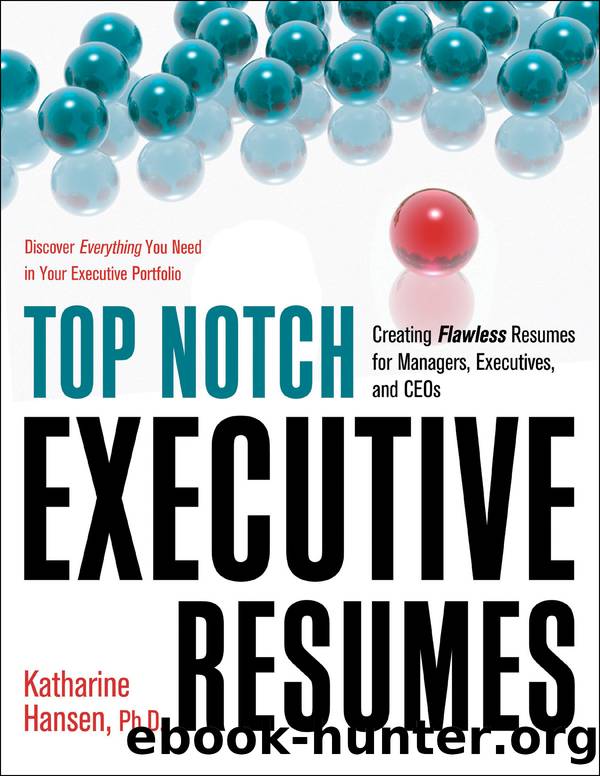Top Notch Executive Resumes by Katharine Hansen

Author:Katharine Hansen
Language: eng
Format: epub
Publisher: Red Wheel Weiser
Published: 2008-03-15T00:00:00+00:00
âcontributed by Makini Theresa Harvey, Principal, Career Abundance
âcontributed by Makini Theresa Harvey, Principal, Career Abundance
Networking Communication Tools
Elevator Speech
By now the elevator speech, also known as an elevator pitch, is a fairly well-known tool, not only for job-seekers but also for organizations and individuals with products and services to sell. Authors of numerous articles on the elevator speech offer speculations on the origin of the termâranging from the notion that we often run into important people in elevators to the more common explanation that the elevator speech is a clear, concise bit of communication that can be delivered in the time it takes folks to ride from the top to the bottom of a building in an elevator.
Whatever the exact origin, the elevator speech is an exceptionally useful and versatile tool in numerous situations:
Events designed specifically for networking.
The casual networking opportunities we encounter nearly every dayâthe kidsâ soccer games, plane flights, waiting in line to buy tickets, and so on.
Cold calls to employers.
Cold calls to absent employers: Rita Fisher of Career Change Resumes suggests that leaving your elevator speech in the form of a voice-mail message virtually guarantees that the employer will call back. Hint: Assuming your speech is sufficiently compelling, call after hours when you know for sure you will get the employerâs voice mail.
Opportunities within your own company to talk with those whose positions to which you aspire, let them know youâre doing a great job, and position you for promotion.
Job interviews, where the elevator speech can provide the answer to at least two common interview queries: âTell me about yourselfâ and âWhy should we hire you?â
Wide variation exists among experts as to the ideal length of an elevator speech. Some authors say as few as 15 seconds; others say up to three minutes. Thereâs no reason, however, that you canât employ both short and long versions. Different situations, after all, may well call for diverse approaches. The trick is to make your elevator speech so intriguing that people will want to spend more time talking with you.
At its most basic level, the elevator speechâs structure is:
Hi, my name is ___________. Iâm in the _______________ field, and Iâm looking to _____________________.
The last blank would be filled in with your current career aspiration, whether it is to stay within your field and move up or move into a different career. You will probably want to embellish the speech with more details. Note also that you may want to incorporate elements of your branding statement into your speech. Test your speech on members of your inner circle. Then, based on the situation, append a request for action. Here are some action items that can be appended in various situations:
In a networking situation:
âWhat advice do you have for me? Can you suggest any employers I should be contacting?â
Download
This site does not store any files on its server. We only index and link to content provided by other sites. Please contact the content providers to delete copyright contents if any and email us, we'll remove relevant links or contents immediately.
| Business School Guides | GMAT |
| Guides | Interviewing |
| Job Hunting | Job Markets & Advice |
| Resumes | Vocational Guidance |
| Volunteer Work |
The Motivation Myth by Jeff Haden(4535)
Audition by Ryu Murakami(4107)
Adulting by Kelly Williams Brown(3681)
The Confidence Code by Katty Kay(3576)
Waiting in the Wings by Melissa Brayden(2816)
A Mind For Numbers: How to Excel at Math and Science (Even If You Flunked Algebra) by Barbara Oakley(2694)
Self-Esteem by Matthew McKay & Patrick Fanning(2608)
Nice Girls Don't Get the Corner Office by Lois P. Frankel(2598)
The ONE Thing by Gary Keller(2529)
The Dictionary of Body Language by Joe Navarro(2438)
Fooled by Randomness: The Hidden Role of Chance in Life and in the Markets by Nassim Nicholas Taleb(2420)
How to be More Interesting by Edward De Bono(2361)
Getting Things Done by David Allen(2322)
Designing Your Life by Bill Burnett(2278)
The Plant Paradox by Dr. Steven R. Gundry M.D(2049)
Police Exams Prep 2018-2019 by Kaplan Test Prep(2039)
What Color Is Your Parachute? 2015 by Richard N. Bolles(1932)
Dangerous Personalities by Joe Navarro(1898)
When to Jump by Mike Lewis(1812)
